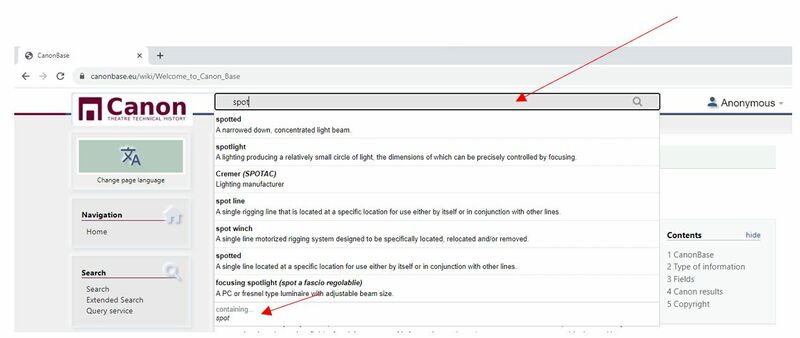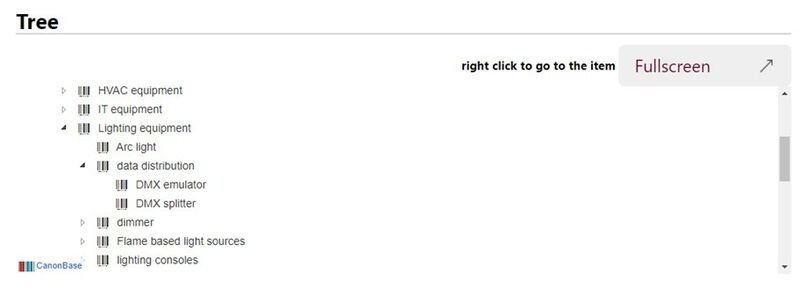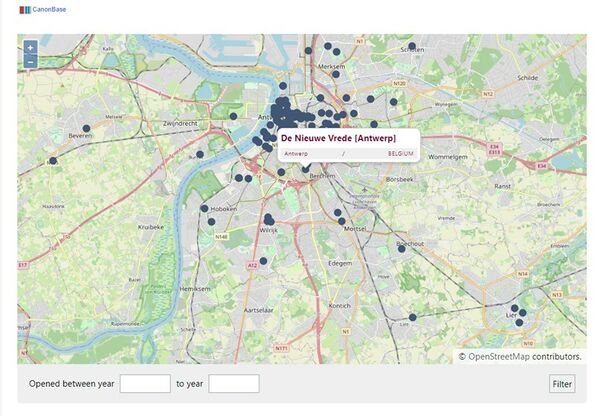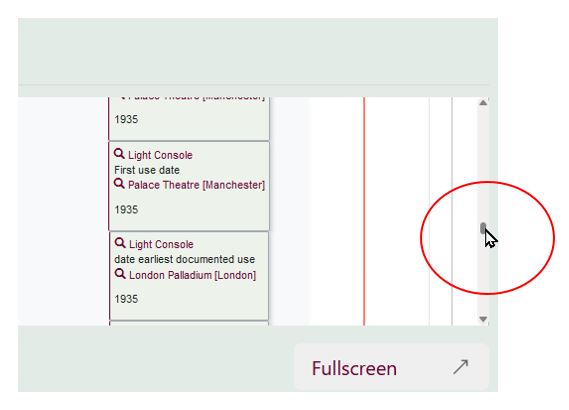Difference between revisions of "Help:Finding your way"
| (6 intermediate revisions by 2 users not shown) | |||
| Line 1: | Line 1: | ||
| − | + | There are many different ways to find information in the Canonbase. The structure is built so that everything is connected to everything, but there are different entries that help you find what you are looking for. | |
| − | |||
| − | There are many different ways to find information in the Canonbase. The structure is | ||
==Using the main structure== | ==Using the main structure== | ||
| − | All the items are structured in a matrix of Fields and types of information. An overview of these can be accessed from the main/home page and from the left | + | All the items are structured in a matrix of Fields and types of information. An overview of these can be accessed from the main/home page and from the menu on the left of each page. |
| − | The '''fields''' | + | The '''fields''' reflect the nature of technical theatre, but include also more general historic and technical fields. If you are looking for information on a specific field, this is a good start. The main page will show you overviews of what is available in this field. |
| − | The '''type of information''' reflect | + | The '''type of information''' reflect the various kinds of concepts and items that are collected in the Canonbase. If you are looking for a specific type, this is a good start. The main page of each type will show you different overviews of the information available. |
If you are looking for information about a specific '''geographic area''', just type the name of the continent, country, region, province or city in the search bar. | If you are looking for information about a specific '''geographic area''', just type the name of the continent, country, region, province or city in the search bar. | ||
| Line 17: | Line 15: | ||
==Using the search bar== | ==Using the search bar== | ||
| − | The search bar will search for any label, independent of the language, that matches your search. | + | The search bar will search for any label, independent of the language, that matches your search. It is important to be aware the search only looks from the start of the label. If you don’t find what you are looking for, because the word you are looking for is not at the start of the label, click '''containing''' at the end of the list. |
[[File:Help_Search_finding.jpg|800px|thumb|center|Map]] | [[File:Help_Search_finding.jpg|800px|thumb|center|Map]] | ||
| − | + | This will also give you results where the word you are looking for is somewhere in the label or in the description. The '''advanced''' link in the search menu allows you to search for specific types of content. | |
| − | This will give you | ||
== Using trees == | == Using trees == | ||
| − | + | Some items include trees that structure the information in different ways. To open one of the items, you need to right-click on the item. If you want to see a bigger version of the tree, click on the “full screen” button. | |
[[File:Help_Tree_finding.jpg|800px|thumb|center|Map]] | [[File:Help_Tree_finding.jpg|800px|thumb|center|Map]] | ||
== Using maps == | == Using maps == | ||
| − | The maps | + | The maps indicate the geographic positions of items, if that information is available. You can zoom in or out by scrolling on the map or using the + and - buttons. You can move the map by left-clicking and dragging. If you click on a dot, you will see the name, city and country of the venue, a simple click will bring you to the information. |
| − | Some maps offer the possibility to filter | + | |
| + | Some maps offer the possibility to filter by the opening dates of the theatres. | ||
[[File:Help_Map_finding_.jpg|600px|thumb|center|Map]] | [[File:Help_Map_finding_.jpg|600px|thumb|center|Map]] | ||
== Using the timelines == | == Using the timelines == | ||
| − | Items that contain more than one date property, or have | + | Items that contain more than one date property, or that have underlying items that contain dates, will show a timeline with these dates. This timeline helps to get a historic overview, but can also be used to surf to other items. The timeline you see in a page is the embedded mode, but by clicking on the full screen button, you get a full screen timeline. |
| − | + | You can navigate the timelines as follows: | |
=== In embedded mode === | === In embedded mode === | ||
| − | + | * To '''go to an item''', click on the item. A new page will open. | |
| − | * To '''go to an item''', click on the item | ||
* To '''scroll left - right''', left-click and drag. | * To '''scroll left - right''', left-click and drag. | ||
* To '''scroll up - down''', use the sidebar that appears when you move your mouse in that direction. (see image below) | * To '''scroll up - down''', use the sidebar that appears when you move your mouse in that direction. (see image below) | ||
| − | * To '''zoom the timeline,''' put your mouse on the timeline and | + | * To '''zoom the timeline,''' put your mouse on the timeline, hold down the Control key and scroll. The timeline will zoom to show a longer or shorter time period. |
| Line 49: | Line 46: | ||
=== In full screen mode === | === In full screen mode === | ||
| − | To | + | To enter full screen mode, click on the Fullscreen button. A new page with the timeline will open. |
| − | * To '''go to an item''', click on the item | + | * To '''go to an item''', click on the item. A new page will open. |
* To '''scroll left - right''', left-click and drag. | * To '''scroll left - right''', left-click and drag. | ||
* To '''scroll up - down''', use the sidebar that appears when you move your mouse in that direction. | * To '''scroll up - down''', use the sidebar that appears when you move your mouse in that direction. | ||
| − | * To '''zoom the timeline''', put your mouse on the timeline and | + | * To '''zoom the timeline''', put your mouse on the timeline, hold down the Control key and scroll. The timeline will zoom to show a longer or shorter time period. |
| − | * To '''zoom the size of the text''', put your mouse outside the timeline and | + | * To '''zoom the size of the text''', put your mouse outside the timeline, hold down the Control key and scroll. The text will become smaller. |
Latest revision as of 20:55, 22 August 2023
There are many different ways to find information in the Canonbase. The structure is built so that everything is connected to everything, but there are different entries that help you find what you are looking for.
Contents
Using the main structure
All the items are structured in a matrix of Fields and types of information. An overview of these can be accessed from the main/home page and from the menu on the left of each page.
The fields reflect the nature of technical theatre, but include also more general historic and technical fields. If you are looking for information on a specific field, this is a good start. The main page will show you overviews of what is available in this field.
The type of information reflect the various kinds of concepts and items that are collected in the Canonbase. If you are looking for a specific type, this is a good start. The main page of each type will show you different overviews of the information available.
If you are looking for information about a specific geographic area, just type the name of the continent, country, region, province or city in the search bar.
Once you have found your scope, you can continue clicking on items in the properties, the tree structures, the time lines or the maps.
Using the search bar
The search bar will search for any label, independent of the language, that matches your search. It is important to be aware the search only looks from the start of the label. If you don’t find what you are looking for, because the word you are looking for is not at the start of the label, click containing at the end of the list.
This will also give you results where the word you are looking for is somewhere in the label or in the description. The advanced link in the search menu allows you to search for specific types of content.
Using trees
Some items include trees that structure the information in different ways. To open one of the items, you need to right-click on the item. If you want to see a bigger version of the tree, click on the “full screen” button.
Using maps
The maps indicate the geographic positions of items, if that information is available. You can zoom in or out by scrolling on the map or using the + and - buttons. You can move the map by left-clicking and dragging. If you click on a dot, you will see the name, city and country of the venue, a simple click will bring you to the information.
Some maps offer the possibility to filter by the opening dates of the theatres.
Using the timelines
Items that contain more than one date property, or that have underlying items that contain dates, will show a timeline with these dates. This timeline helps to get a historic overview, but can also be used to surf to other items. The timeline you see in a page is the embedded mode, but by clicking on the full screen button, you get a full screen timeline.
You can navigate the timelines as follows:
In embedded mode
- To go to an item, click on the item. A new page will open.
- To scroll left - right, left-click and drag.
- To scroll up - down, use the sidebar that appears when you move your mouse in that direction. (see image below)
- To zoom the timeline, put your mouse on the timeline, hold down the Control key and scroll. The timeline will zoom to show a longer or shorter time period.
In full screen mode
To enter full screen mode, click on the Fullscreen button. A new page with the timeline will open.
- To go to an item, click on the item. A new page will open.
- To scroll left - right, left-click and drag.
- To scroll up - down, use the sidebar that appears when you move your mouse in that direction.
- To zoom the timeline, put your mouse on the timeline, hold down the Control key and scroll. The timeline will zoom to show a longer or shorter time period.
- To zoom the size of the text, put your mouse outside the timeline, hold down the Control key and scroll. The text will become smaller.



